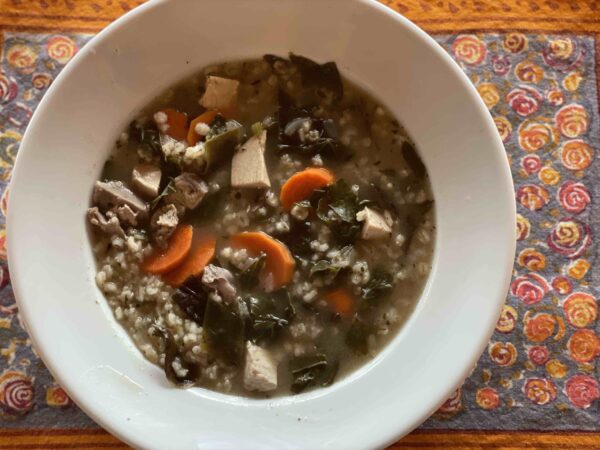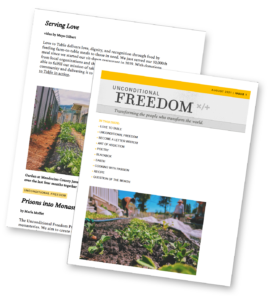by Louise Ayer
I am tired from hosting Thanksgiving this year, but I did it, which amazes me that I could pull it off, at 75 with Parkinson’s. But the point is, I didn’t do it alone. We all did it together. Looking back on Thanksgiving, I’d like to take a moment before we move on to Christmas and all its lovely possibilities for celebration.
Thanksgiving is such a wonderful idea, devoting a major holiday to gratitude and connection. I feel grateful for so many things, my beautiful, caring husband, my children who have devoted their lives to community and caring for others, to my friends and relatives who I love and who love me. We did Thanksgiving together. We could not have done it alone.
But I am tired, so I am going to keep this short and sweet. Another thing I am always grateful for at Thanksgiving is the leftovers. I love to be able to open my refrigerator door, to look inside and dream about the possibilities of what to do with all those leftovers. We like to cook a turkey bigger than we need to, so I can make turkey stock, turkey shepherd’s pie and turkey soup. This year we cooked two turkeys, so I could give a carcass to my friend Gail and she and I could both make stock. I have enough turkey meat to make soup and turkey sandwiches with homemade cranberry sauce, I have mashed potatoes to nestle on top of my shepherd’s pie and gravy to make a sauce. I still have Swiss chard and kale growing in the garden to put in my turkey barley soup. Riches all! And what we cannot eat we can turn into compost to feed Mother Earth. I am truly grateful.
A note about barley: barley is an underutilized grain that I would like to honor. I would not exist if it were not for barley. My Grandmother, Dee, had eight miscarriages before she conceived my mother. Even my mother she could only carry for seven months. Mom was born in 1910, at home, weighing only 2 ½ pounds. Dee lined a wicker clothes basket with hot water bottles and used that as an incubator. But Mom’s digestive system was not developed enough to even accept breast milk. Somehow Dee knew to make a formula with barley water and lime juice. It was the barley water that kept her alive.
I Googled barley this morning. Barley is low in calories and high in fiber. It is loaded with amino acids and helps to regulate blood sugar. Barley boosts the immune system and its high copper content helps with the formation of red blood cells. I am grateful that Dee knew about barley and kept my dear mamma alive.
This time of year, when much of what we eat is so rich, it is wonderful to be able to make a soup that is so nourishing for us to finish off the holiday with.
Turkey Barley Soup
Serves 6-8
Ingredients:
3 quarts of homemade turkey stock or store-bought organic turkey or chicken stock (See the 10th issue, June, of Unconditional Freedom newsletter, for how to make bone broth and substitute turkey for chicken.)
1 cup of pearled barley
3 to 4 medium carrots, peeled and cut into ½-inch coins
3 to 4 stalks of celery, thinly sliced
1 medium onion, cut in ½-inch dice
4 cloves minced garlic
2 tablespoons minced, fresh flat leaf Italian parsley
1 bunch greens, Swiss chard or kale, center rib removed and coarsely chopped
1 heaping tablespoon, crushed, dried herbs, a combination of oregano, thyme and sage
2 teaspoons salt
20 grinds of black pepper
¼ teaspoon freshly grated nutmeg
3 to 4 cups chopped leftover turkey meat
1 quart of water if soup is thicker than you prefer
Pour the stock into a large soup pot. Add the barley. Bring stock to a boil. Turn down to simmer and cook for 45 minutes. In the meantime, prep all the vegetables and the turkey. After the barley has cooked for 45 minutes, add all the remaining ingredients except for the turkey and water. Simmer for 15 more minutes until the vegetables are tender, then add the turkey. Add the water if the soup is thicker than you like. Bring the soup back to a boil, and then shut off the heat so as not to overcook the meat. This soup will be even more delicious the second day.

 Get access to the monthly Rehumanization Magazine featuring contributors from the front lines of this effort—those living on Death Row, residents of the largest women’s prison in the world, renowned ecologists, the food insecure, and veteran correctional officers alike.
Get access to the monthly Rehumanization Magazine featuring contributors from the front lines of this effort—those living on Death Row, residents of the largest women’s prison in the world, renowned ecologists, the food insecure, and veteran correctional officers alike.